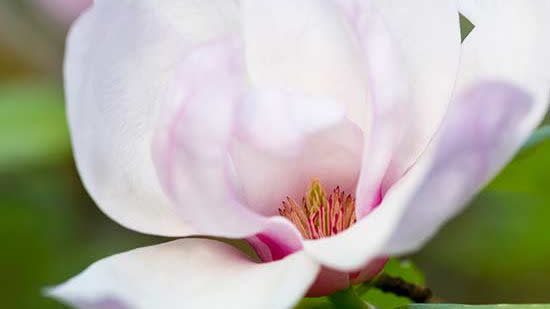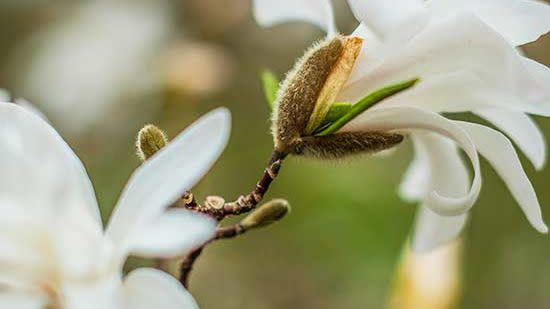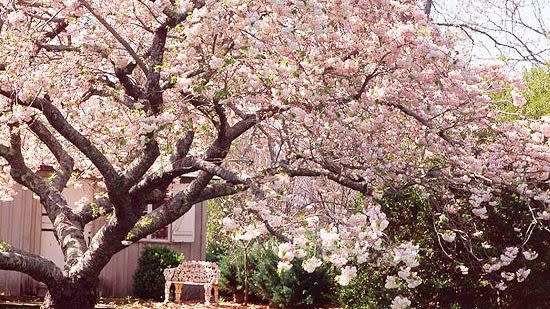How to Grow Magnolia Trees

Undoubtedly one of the most stunning additions to any ornamental landscape, the majestic magnolia tree is as lovely as it is low-maintenance. While it's almost impossible to resist the allure of the storied blossoms, their dramatic forms, and intoxicating fragrance, the tree itself is a hardy and sculptural beauty. The dense, waxy magnolia foliage provides an attractive contrast to those gorgeous blooms while creating shelter for migratory birds. The fall-borne seed cones burst with vibrant red seeds that are gobbled up by those seasonal visitors.
If you've ever hesitated to plant a magnolia tree because you've wondered how to grow one, or whether you can even grow one at all, rest assured—you can, and with very little effort. Though most of the 200-plus species prefer tropical and subtropical climates, there are cultivars adapted to nearly every growing zone. With sizes ranging from shrubs to dwarf trees, to trees that are up to 100 feet tall, there's a magnolia tree that will work for almost every landscape.

Magnolia Tree Varieties
The first and most important step is, of course, figuring out just what varieties will suit your zone and space needs. Some popular options are:

Southern Magnolia Tree (Magnolia grandiflora)
These are the grande dames of magnolias. They can grow up to 90 feet tall, and their creamy, perfumed blossoms can reach up to 10 inches in diameter. Suited best to Zones 7–9, grandiflora will actually do quite well in a broad range of climates and is the most prevalent type of magnolia. Even better, there are many smaller or dwarf cultivars of the grandiflora, such as the Little Gem magnolia tree, which grows to 15–20 feet tall.

Japanese Magnolia (Magnolia x soulangeana)
Often called a saucer or tulip magnolia, soulangeana is a hybrid between the Yulan magnolia and the lily magnolia, producing goblet-shaped flowers in purple, pale pink, magenta, and even white or yellow. Considered a small magnolia tree, it's deciduous and compact, growing only to about 15 feet tall (and many consider it to be a shrub). Japanese magnolias are best suited for Zones 4–9. All types of this stunner will flower in the early spring, before leaf buds open, for a striking display of blooms on bare branches. One of the most popular cultivars of soulangeana is the Jane magnolia tree (Magnolia x 'Jane'), which produces lovely purplish-red flowers that open to a pale pink or white center.

Sweet Bay Magnolia (Magnolia virginiana)
Native to the southeastern United States, this hardy variety (the very first ever classified) is adaptable to Zones 4–10, and it's deciduous or evergreen, depending on the Zone in which it's grown. In its native southern climate, it can grow to be 50 feet tall and is evergreen. It's hardy in Northern climates, but will grow as a deciduous, or semi-evergreen, smaller bush-type tree. It features similar blossoms to those of its cousin the grandiflora, but they're much smaller in size, measuring around three inches in diameter. Its lighter-colored leaves are quite fragrant.
Star Magnolia (Magnolia stellata)
This deciduous late-winter bloomer produces masses of fragrant white to light pink flowers on bare branches, before its foliage starts to appear in spring. It's a small magnolia tree, reaching 10–20 feet in height, but because it's a slow grower, it will for years make a fantastic ornamental shrub. Performs best in Zones 4–9.
Planting a Magnolia Tree
Planting a magnolia is a pretty straightforward process. Once you've decided on the type that will do best on your property, it's time to start digging. Select a spot in full sun (or partial sun in hotter regions), away from other landscaping. Magnolias don't like to be crowded, and once established, they don't like to be moved. Don't plant anything beneath them (this includes grass), as the leaves will fall and smother anything below them (but left to decompose as a mulch, the leaves will provide essential nutrients to the tree). Select a location with moist but well-drained, rich, neutral to slightly acidic soil, or amend to make it so. Keep in mind that deciduous magnolia varieties are best planted in early spring, while dormant.
After choosing the planting location, dig a hole at least one and a half times the width of the root ball, or bundle, of your specimen and slightly less deep. Remove the upper layer of soil from the tree so that root at the very top is exposed. You want this root to be exactly level with the ground around the planting hole. Mix plenty of organic compost into the surrounding soil. Fill the planting hole halfway up with soil, making sure the tree is straight. Fill the half-filled hole with water, let it drain, then fill fully with soil, being sure to leave that top root exposed. Cover with a few inches of mulch. Keep young trees well-watered until they're established, and feed them with a slow-release fertilizer in spring, before the flower buds fully form.

Saucer magnolia.
Caring for a Magnolia Tree
When established in the proper location and climate, magnolias are exceptionally carefree. Resistant to diseases and pests, they take just a little basic maintenance. What they don't do well with, however, is damage. Magnolia wounds are notoriously slow to heal. Heavy pruning or damage to the trunk or roots can be catastrophic. For this reason, it's best not to underplant your tree. Digging among the roots, or inadvertent nicks by lawnmowers or weed trimmers, can result in irreversible damage. Keep routine pruning to a minimum, and do it only after the tree has flowered. The rest of the time, only prune damaged branches or limbs on an as-needed basis.
With just a little planning and maintenance, magnolia trees will be the absolute star of your garden for a lifetime.
